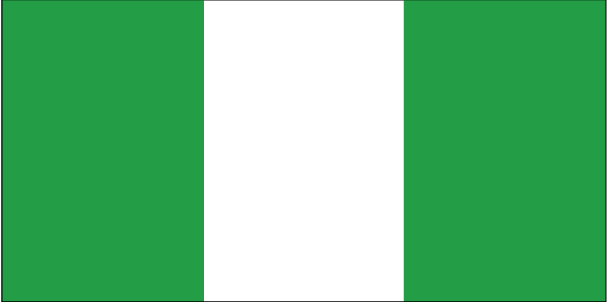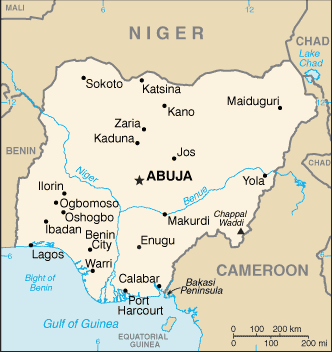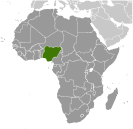
|
|
Advertisements:
People And SocietyNationality
Noun Nigerian(s)
Adjective Nigerian Ethnic groups
Nigeria, Africa's most populous country, is composed of more than 250 ethnic groups; the following are the most populous and politically influential: Hausa and Fulani 29%, Yoruba 21%, Igbo (Ibo) 18%, Ijaw 10%, Kanuri 4%, Ibibio 3.5%, Tiv 2.5% Languages
English (official), Hausa, Yoruba, Igbo (Ibo), Fulani, over 500 additional indigenous languages Religions
Muslim 50%, Christian 40%, indigenous beliefs 10% Population World Ranking: 7
170,123,740 (July 2012 est.)
Note Estimates for this country explicitly take into account the effects of excess mortality due to AIDS; this can result in lower life expectancy, higher infant mortality, higher death rates, lower population growth rates, and changes in the distribution of population by age and sex than would otherwise be expected Age structure
0-14 years
40.9% (male 32,476,681/female 31,064,539) 15-64 years 55.9% (male 44,296,228/female 42,534,542) 65 years and over 3.1% (male 2,341,228/female 2,502,355) (2011 est.) Median age
Total 17.9 years
Male 17.5 years Female 18.4 years (2012 est.) Population growth rate World Ranking: 27
2.553% (2012 est.)
Birth rate World Ranking: 14
39.23 births/1,000 population (2012 est.) Death rate World Ranking: 18
13.48 deaths/1,000 population (July 2012 est.) Net migration rate World Ranking: 123
-0.22 migrant(s)/1,000 population (2012 est.) Urbanization
Urban population 50% of total population (2010)
Rate of urbanization 3.5% annual rate of change (2010-15 est.) Major cities - population
Lagos 10.203 million; Kano 3.304 million; Ibadan 2.762 million; ABUJA (capital) 1.857 million; Kaduna 1.519 million (2009) Sex ratio
At birth 1.06 male(s)/female
Under 15 years 1.05 male(s)/female 15-64 years 0.99 male(s)/female 65 years and over 0.85 male(s)/female Total population 1.01 male(s)/female (2011 est.) Maternal mortality rate World Ranking: 10
630 deaths/100,000 live births (2010) Infant mortality rate World Ranking: 16
Total 74.36 deaths/1,000 live births
Male 79.44 deaths/1,000 live births Female 68.97 deaths/1,000 live births (2012 est.) Life expectancy at birth World Ranking: 211
Total population 52.05 years
Male 48.95 years Female 55.33 years (2012 est.) Total fertility rate World Ranking: 13
5.38 children born/woman (2012 est.) Health expenditures World Ranking: 117
5.8% of GDP (2009)
Physicians density
0.395 physicians/1,000 population (2008) Hospital bed density
0.53 beds/1,000 population (2004) Hiv/aids - adult prevalence rate World Ranking: 17
3.6% (2009 est.)
Hiv/aids - people living with hiv/aids World Ranking: 2
3.3 million (2009 est.)
Hiv/aids - deaths World Ranking: 2
220,000 (2009 est.)
Major infectious diseases
Degree of risk Very high
Food or waterborne diseases Bacterial and protozoal diarrhea, hepatitis A and E, and typhoid fever Vectorborne disease Malaria and yellow feverRespiratory disease Meningococcal meningitis Aerosolized dust or soil contact disease One of the most highly endemic areas for Lassa fever Water contact disease Leptospirosis and shistosomiasis Animal contact disease RabiesNote Highly pathogenic H5N1 avian influenza has been identified in this country; it poses a negligible risk with extremely rare cases possible among US citizens who have close contact with birds (2009) Children under the age of 5 years underweight World Ranking: 24
26.7% (2008)
Education expenditures
NA
Literacy
Definition
Age 15 and over can read and write Total population 61.3%Male 72.1% Female 50.4% (2010 est.) School life expectancy (primary to tertiary education)
Total 9 years
Male 10 years Female 8 years (2005)
Comments
Add a new comment: |
Advertisement
Members area
Nigeria (Abuja):
 
GPS points from Nigeria (Abuja)
|
||||||||

 British influence and control over what would become Nigeria and Africa's most populous country grew through the 19th century. A series of constitutions after World War II granted Nigeria greater autonomy; independence came in 1960. Following nearly 16 years of military rule, a new constitution was adopted in 1999, and a peaceful transition to civilian government was completed. The government continues to face the daunting task of reforming a petroleum-based economy, whose revenues have been squandered through corruption and mismanagement, and institutionalizing democracy. In addition, Nigeria continues to experience longstanding ethnic and religious tensions. Although both the 2003 and 2007 presidential elections were marred by significant irregularities and violence, Nigeria is currently experiencing its longest period of civilian rule since independence. The general elections of April 2007 marked the first civilian-to-civilian transfer of power in the country's history.
British influence and control over what would become Nigeria and Africa's most populous country grew through the 19th century. A series of constitutions after World War II granted Nigeria greater autonomy; independence came in 1960. Following nearly 16 years of military rule, a new constitution was adopted in 1999, and a peaceful transition to civilian government was completed. The government continues to face the daunting task of reforming a petroleum-based economy, whose revenues have been squandered through corruption and mismanagement, and institutionalizing democracy. In addition, Nigeria continues to experience longstanding ethnic and religious tensions. Although both the 2003 and 2007 presidential elections were marred by significant irregularities and violence, Nigeria is currently experiencing its longest period of civilian rule since independence. The general elections of April 2007 marked the first civilian-to-civilian transfer of power in the country's history.